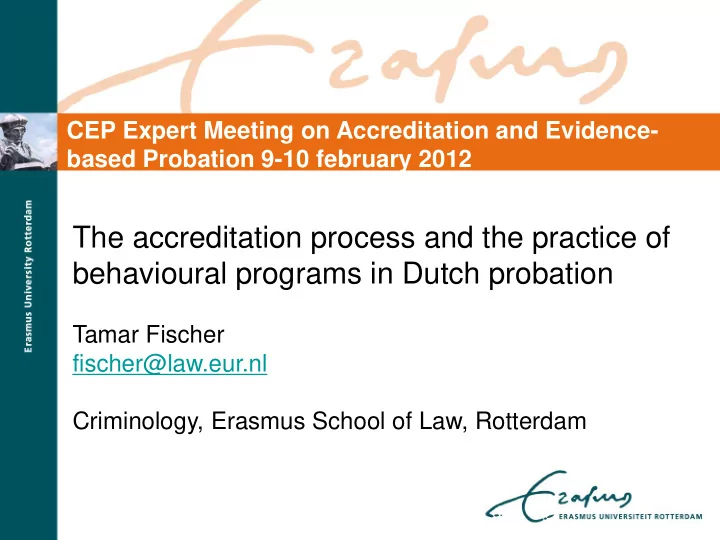

CEP Expert Meeting on Accreditation and Evidence- based Probation 9-10 february 2012 The accreditation process and the practice of behavioural programs in Dutch probation Tamar Fischer fischer@law.eur.nl Criminology, Erasmus School of Law, Rotterdam
Accreditation in The Netherlands • 1 accreditation panel • Since 2005 • 11 behavioural scientists and/or experts in practice Tasks • Behavioural programs for juvenile / adult offenders • Analyzed on 10 criteria
Criteria 1. Theoretical model 2. Clear selection criteria 3. Direct criminogenic factors 4. Effective or promising methods 5. Training of skills 6. Intensity based on risk principle 7. Attention to motivation of participants 8. Continuity intervention and supervision trajectory 9. Intervention integrity 10.Evaluation plan (continuous evaluation)
Ambition probation and department 2005 To select a set of behavioural programs, that: • Addresses all criminogenic needs • Reaches all (possible) groups of offenders • Have a limited number of different programs • That are effective or at least promising
Erasmus University Rotterdam Study (Fischer, Captein, Zwirs, 2012) - Which criminogenic needs unaddressed? - Which offender groups unreached and why? - Which adjustments or additions can be advised?
Methods - Content analyses - program manuals (probation) - methods of diagnosis manual - Interviews - policy makers - trainers - program supervisors - RISc advisors - Client database (2010) - RISc items (criminogenic needs/exclusion criteria) - course of correctional program participation (files)
Results about relation of accreditation with 1. Selection of programs 2. Indication criteria for programs 3. Practice and position of programs
1. Selection of programs offered by probation Approved programs for adult offenders 2012 • Cognitive skills • Cognitive skills for intellectually dissabled • Addiction related relapse prevention regular • Addiction related relapse prevention short • Working skills • ART-Wiltshire • Alcohol and Violence (temporarily approved)
Not approved programs adult offenders • Financial behaviour/budgetting (had temporal status) • Housing and living behaviour (had temporal status) • Behavioural program partner violence
General characteristics programs • All programs are fixed group programs • No modular programs • For intellectualy disabled, just cognitive skills training
Conclusions selection of programs - Important criminogenic needs not addressed - housing and living behaviour - financial behaviour/budgetting - Limited set fixed programs limited individual fit? - no ‘easy to enter’ motivational programs - overload when more criminogenic needs - no individual versions of group programs - no supply for short sentenced prisoners
2. Theory/practice indication criteria - Programs clearly describe criteria based on RISc but ……
Difference between needs and subscriptions (N=12.226) 10,000 9,000 8,000 7,000 6,000 5,000 RISc with need 2010 Clients subscribed 2010 4,000 3,000 2,000 1,000 0 Cognitive Addiction Working skills ART-Wiltshire Alcohol and Budgetting Housing and skills (+) relapse (ARVA) Violence Living (CoVa) prevention
Partly explained by indication and advise process - Prevalence exclusion criteria high
Exclusion criteria with high prevalence (>20%) - psychiatric problems (up to 45% in probation) - addiction - intellectual disabilities - lack of motivation - disruptions in daily living (housing/relations) - dominant behavior All these factors are difficult to diagnose
Partly explained by indication and advise process - Prevalence exclusion criteria high - Criteria complex and varying - Reasoning for criteria not always clear - Ask for in depth diagnostics - Uncertainty leads to indicating forensic treatment/care?
3. Practice and position of programs Strong focus on quality and integrity of programs but:
Trainers experience limited flexibility when - Examples do not concern the participants - The level of the exercises is too high/low - Participants need more individual attention
Few evaluation studies available program name approved proces effect since evaluation evaluation Cognitive skills 2005 2009 2012 (?) Cognitive skills + 2006 2011 - Relapse prevention 2006/2007 2012 (?) - Working skills 2006 - - ART-Wiltshire 2007 - - Alcohol & Violence 2009 - -
Uncertainty and long waiting times few training groups advisors programs no new prefer stay registrations certainty unknown
Programs have an isolated position: - Within organization - advisors are unfamiliar with programs - Within trajectories; with respect to: - supervising probation officer (varies strongly) - motivational interventions - psychiatric/addiction treatment? - work, housing and budgeting programs?
Summary of results - not for structural needs 1. Selection of - individual fit limited programs - groups unreached - many excluded 2. Indication criteria - more diagnostics for programs - relation forensic care? - stagnation 3. Practice and position of programs - isolated position
Future research - Practice of indicating / advising with RISc - Differences between regions: - advise for behavioral programs - % of starters - % of no-shows/drop outs - Process/effect evaluations
Main conclusions - Theoretically well developed programs - Most important criminogenic factors addressed Stagnation in: - participation clients unreached? - evaluation improving of practice of the programs Isolation with respect to: - trajectories behavioral changes may not sustain - other providers inefficiency
Recommend
More recommend